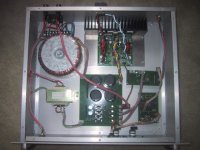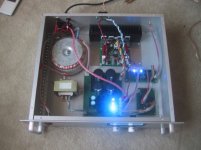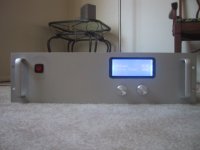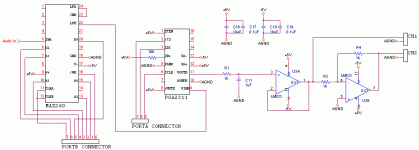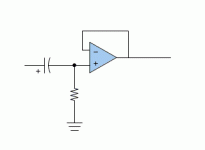Just thought id let you guys see my project see what you guys think. Its a subwoofer amplifier based on the Tripath TK2350 evaluation board. My power supply is +/-45Vdc. The preamp stage has a MAX260 switched cap filter which i have programmed as a 4th order butterworth(can easily change to bessel if you guys think thats better) with an adjustable cutoff frequency from 60Hz to 120Hz in 5Hz steps. Next is a PGA2311 stereo volume IC, im only using one channel of course. The gain is from -30dB to +30dB in 3dB, then 2dB then 1dB steps as the gain gets higher. All of this is adjusted with optical rotary encoders and an Atmel Mega16 micro. Also the LCD displays the volume and x-over settings.
Now the issues. I didnt buffer the signal between the Max260 and the PGA2311. I dont think the 260 is able to drive the 2311. Would that cause this rumbling i get? Its not a ground loop for when i increase the x-over i hear higher frequency noise.
Now the issues. I didnt buffer the signal between the Max260 and the PGA2311. I dont think the 260 is able to drive the 2311. Would that cause this rumbling i get? Its not a ground loop for when i increase the x-over i hear higher frequency noise.
Attachments
Hey Deltat, that piece looks really nice!
Please post sch. we always wanna se that 😉
Wished i could do that programming though, have some PGAs and WM8816 i would like to do something with
Please post sch. we always wanna se that 😉
Wished i could do that programming though, have some PGAs and WM8816 i would like to do something with

The programming was pretty easy actually. Im not a software guy, infact i HATE it.
Heres a schamatic of the pre-amp board. Ignore the power pins on the LM833. Its an 8-pin chip but i used the schemic from a lm324 since i did this on my home computer with evaluation version. Also the LP filter after the PGA2311 is to block the switching noise generated on the MAX260. With a max fclkc/fo ratio of 200 the clock frequency was in the audio range, 12k-24kHz.
Heres a schamatic of the pre-amp board. Ignore the power pins on the LM833. Its an 8-pin chip but i used the schemic from a lm324 since i did this on my home computer with evaluation version. Also the LP filter after the PGA2311 is to block the switching noise generated on the MAX260. With a max fclkc/fo ratio of 200 the clock frequency was in the audio range, 12k-24kHz.
Attachments
Member
Joined 2004
Hi
You should build an active crossover(low pass).12/db per octave is adequate for a quick experiment,this should only require a handful of parts.Substitute this for the MAX260 circuit you have.Having a clock frequency in the audio range is not good. harmonics will find their way into your output stages.I assume you looked at your signal with an 0-scope?
You should build an active crossover(low pass).12/db per octave is adequate for a quick experiment,this should only require a handful of parts.Substitute this for the MAX260 circuit you have.Having a clock frequency in the audio range is not good. harmonics will find their way into your output stages.I assume you looked at your signal with an 0-scope?
Generally speaking, switched cap filters suck for audio. The clock that drives the capacitor switches always finds it's way into the audio. I'd replace that thing with an opamp circuit. You could put in some reed relays to switch some of the components if you must have a variable cutoff frequency.
I_F
I_F
Member
Joined 2002
Member
Joined 2002
Dude small world! I saw you working on your amp in MGL a few weeks ago, my lab partner and i were asking you all these questions. Im glad it turned out well. 231 test tomorrow 

At first I was a little conserned about the use of a switched cap filter but my old boss from Klipsch assured me that since im was only dealing with low frequencies it wouldnt be an issue. The RC low pass filter has a cut-off frequency of 160 Hz and filters out the high pitched whine i had.
Thanks for all the positive comments! I hope putting an LM833 voltage follower between the MAX260 and PGA2311 will fix my noise issue. The signal on the o-scope gets pretty dirty, and with a total system gain of 50dB at MAX thats bad.
Im having a slight DC issue. Where you would all suggest a highpass filter with a cut-off of 15Hz should be placed?
Thanks for all the positive comments! I hope putting an LM833 voltage follower between the MAX260 and PGA2311 will fix my noise issue. The signal on the o-scope gets pretty dirty, and with a total system gain of 50dB at MAX thats bad.
Im having a slight DC issue. Where you would all suggest a highpass filter with a cut-off of 15Hz should be placed?
Well i added an opamp voltage follower using an LM833 between the MAX260 and the PGA2311, in hopes tha driving the 2311 with the correct impedence might eliminate this noise im hearing. I think it made it worse 

I'm having a slight DC issue...
Well i added an opamp voltage follower ... I think it made it worse
If operated in single-supply mode, the MAX260 requires an input between 0 and 5 volts DC, so any AC input (like audio) needs to be DC biased to around 2.5 V. If operated in dual supply mode (+5 v and -5 v), then the signal can be referenced to ground instead of to 2.5 V. What is the arrangement of your power supply? Have you properly bypassed the power supply near the IC power pins? (see Application Hints, page 20-22 of MAX260 datasheet). Also take note of the section of the application notes describing aliasing. If your input singnal (audio) contains any signals of frequency higher than 1/2 the sampling clock frequency of the filter, you will get aliasing that will cause all kinds of garbage on the output. Simple nyquist theorem. What's your clock rate? If it isn't higher than 40 kHz, you absolutely need to pre-filter the input signal. Read the datasheet; it's your friend.
Ok here are my observations from testing. The output of the MAX260 is getting a dc of about 100mV. I dont know why this is but this is causing HUGE problems. My system gain is 50dB or approx 300. Yes that is huge but from what i understand LFE outputs of typical home recievers is like 100mV. So whats happening is this dc is getting a gain of 30 through the PGA2311 at full. Small signals get a DC offset, large sine waves turn to triangle waves. So basically my $365 eval board is getting sent crap 🙁
When it came to decoupling caps and such, i didnt put them near the ICS on the board, i place a 10uF and .1uF cap in parallel on each voltage rail where the +/-5V comes to the board. In the picture thats near the two blue LEDs on the top right board.
Then i try to make a LP RC filter on the output of the MAX260 i get no signal on the output. I havent figured out why.
Im guessing my best bet is to just go into my Senior Design Show and Tell with and amp that sounds like crap but works and in the near future try to fix this or get rid of the pre-amp all together and turn this eval board into a stereo amp for my computer or something.
Kurt
When it came to decoupling caps and such, i didnt put them near the ICS on the board, i place a 10uF and .1uF cap in parallel on each voltage rail where the +/-5V comes to the board. In the picture thats near the two blue LEDs on the top right board.
Then i try to make a LP RC filter on the output of the MAX260 i get no signal on the output. I havent figured out why.
Im guessing my best bet is to just go into my Senior Design Show and Tell with and amp that sounds like crap but works and in the near future try to fix this or get rid of the pre-amp all together and turn this eval board into a stereo amp for my computer or something.
Kurt
It's very easy to block DC in an audio signal. You need a capacitor in line with the signal, followed by a resistor to ground. R*C is chosen to provide a low cutoff frequency (around 5 to 10 Hz maybe) and to not load the previous stage too much (R=100 kohm or so). In the attached pic I've drawn a simple buffer with DC blocking. It can be using between any two stages in your system to block DC and provide a low-impedance drive for the next stage. I've shown a polarised cap, but you can (and should if possible) use a non-polised one. If you use a polarised one, orient it the right way. C=1 uF and R=100 kohm should work ok for most apps.
Attachments
That just won't do. You need decoupling caps near every single IC on the board(s). These caps provide local storage of energy for each chip. This helps ensure that each chip gets power when it needs it, and that it doesn't 'dirty' up the power supply for the other components. Digital logic is espeically bad, switching at high frequencies, which can create a lot of noise in the power supply lines. This is one of those practical things that you might not learn in school but need to know.When it came to decoupling caps and such, i didnt put them near the ICS on the board, i place a 10uF and .1uF cap in parallel on each voltage rail where the +/-5V comes to the board.
A 0.1 uF ceramic cap is a common choice for decoupling and is a good start. Every chip needs one on between each of it's power supply lines and ground. If you have made PCB and don't want to re-do the whole thing, you can 'barnacle' these onto your board by just soldering the caps onto the board in the appropriate places. It looks like heck, but it's just part of prototyping. ('barnacle' refers to the fact that there are now components stuck all over the bottom of your board, like barnacles stuck to the bottom of boat).
- Status
- Not open for further replies.
- Home
- Amplifiers
- Chip Amps
- My senior Design Project
